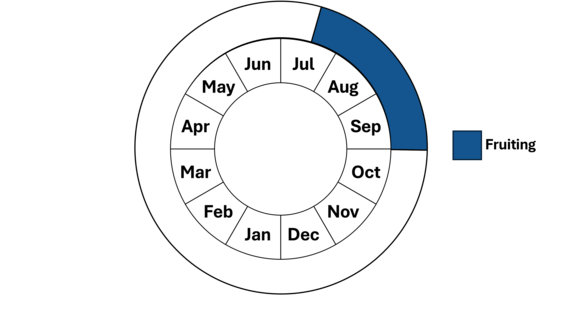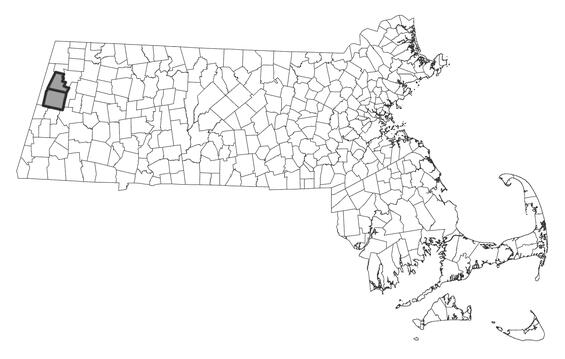- Scientific name: Potamogeton strictifolius
- Species of Greatest Conservation Need (MA State Wildlife Action Plan)
- Endangered (MA Endangered Species Act)
Description
Straight-leaved pondweed (Potamogeton strictifolius) is a slender, submersed aquatic herb rooted to the substrate from erect, rounded, stems 3-9.5 cm (1-4 in) long. Leaf blades are sessile, spirally arranged, and linear, 1.2-6.3 cm (~0.5-2.5 in) long and 0.6-2.0 mm (0.024-0.08) wide. The leaf tips are acute or have a bristle. At the base of each leaf is an inconspicuous stipule, completely free from the blade, and a pair of small (~0.5 mm; 0.02 in), raised “nodal” glands. Flowers are inconspicuous and arranged in short slender spikes held just above the water surface. Fruits are small (~ 2 mm; 0.08 in) and egg-shaped, green-brown in color, with short (0.5-0.8 mm; 0.02-0.03 in) erect beaks. Later in the summer, the formation of leafy winter buds, or turions, is common in the leaf axils or at the ends of the branches. The turions, which are 2.5-5 cm long (1-2 in) and 0.8-2.2 mm (0.03-0.09 in) wide, are soft with 2-ranked leaves; the inner and outer leaves are flattened into the same plane.
The identification of linear-leaved pondweeds (Potamogeton spp.), in general, is difficult and requires careful microscopic (or hand lens) examination of leaves, stipules, nodes, winter buds, and fruit. Straight-leaved pondweed is identified by its two-ranked, fairly stiff, three to five-veined leaf blades, paired nodal glands, flattened turions, and free, whitish, coarsely fibrous stipules (6-16 mm long; 0.24-0.63 in) shredded at the tips. The stipules can be united at their bases when young. Leaves tend to become inwardly rolled along their margins and encrusted with marl (calcium carbonate).
Individuals of straight-leaved pondweed closely resemble other, more common narrow-leaved pondweeds lacking floating blades. In the absence of turions for observation, straight-leaved pondweed can be separated from leafy pondweed (P. foliosus) by its rigid leaves, nodal glands, and keel-less fruits; and from slender pondweed (P. pusillus) by its more-veined (three to five) leaves and white, coarsely fibrous stipules. Straight-leaved pondweed is most often misidentified as the rare Fries’ pondweed (P. friesii), another state-endangered species with an affinity for alkaline waters. Straight-leaved pondweed has flattened turions with inner and outer leaves positioned in the same plane, whereas the turions of Fries’ pondweed are positioned at right angles to each other; further straight-leaved pondweed has more rigid, often bristle-tipped leaves with fewer veins than Fries’ pondweed; the leaves of the latter species has five to seven veins with acute tips.
Life cycle and behavior

Population status
Straight-leaved pondweed is listed under the Massachusetts Endangered Species Act as endangered. All listed species are protected from killing, collecting, possessing, or sale and from activities that would destroy habitat and thus directly or indirectly cause mortality or disrupt critical behaviors. The Natural Heritage & Endangered Species Program has 2 records from 1 county: Berkshire. Neither record has been observed within the last 25 years.
Distribution and abundance
Straight-leaved pondweed occurs from Newfoundland west to British Columbia, south to Utah, Michigan, New York, and Connecticut.

Distribution in Massachusetts. 1999-2024. Based on records in the Natural Heritage Database.
Habitat
Straight-leaved pondweed is restricted to highly calcareous waters of lakes, ponds, and slow streams to 3 m (~10 ft) deep. Plants found in association with straight-leaved pondweed include northern waterweed (Elodea canadensis), water crowfoot (Ranunculus aquatilis), water stargrass (Heteranthera dubia), Eurasian water-milfoil (Myriophyllum spicatum), sago pondweed (Stuckenia pectinata), flatstem pondweed (P. zosteriformis), and big-leaved pondweed (P. amplifolius).
Healthy habitats are vital for supporting native wildlife and plants. Explore habitats and learn about conservation and restoration in Massachusetts.
Threats
As straight-leaved pondweed occurs in open waters, alterations in the hydrologic regime, water quality, or erosion and sedimentation rates could have an impact on a population. Competition from invasive aquatic species could also reduce the available habitat of straight-leaved pondweed. Mechanical or non-specific chemical control of invasive species is a threat as well.
Conservation
All active management of state-listed plant populations (including invasive species removal) is subject to review under the Massachusetts Endangered Species Act and should be planned in close consultation with the MassWildlife’s Natural Heritage & Endangered Species Program.
Contact
| Date published: | May 5, 2025 |
|---|